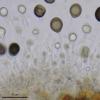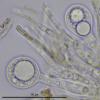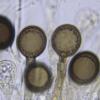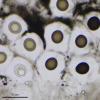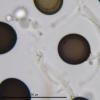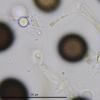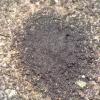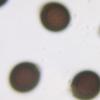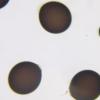
20-12-2025 23:08
Patrice TANCHAUDBonsoir, récolte sur sol sablonneux dans l'arri�

21-12-2025 09:32
Hello.A tiny ascomycete found embedded in wood in

20-12-2025 15:47
Mirek GrycHi.These grew on pine wood that was heavily covere

18-12-2025 21:17
Pol DebaenstThe identification took me to Byssonectria deformi

15-12-2025 07:09
 Danny Newman
Danny Newman
indet. Rutstroemiaceae sp. on unk. fallen leavesMc

19-12-2025 10:10
Patrice TANCHAUDBonjour, récolte réalisée en milieu dunaire, a

18-12-2025 17:23
 Bruno Coué
Bruno Coué
Bonjour,je serais heureux d'avoir votre avis sur c
Conidiomas
Salvador Tello,
04-04-2016 17:59
¿Alguien sabe el nombre de estos conidiomas, o me puede indicar por donde buscar?
Gracias.
Crece en Quercus ilex y los conidios son de (22,5-)24,5-29,5(-32,5) × (20,5-)22,5-25,5(-27,5) µm ligeramente granulosos y envueltos en una masa gelatinosa.
Saludos.
Salvador.
Joey JTan,
04-04-2016 22:01
Re : Conidiomas
Very impressive! Was it on leaves or wood?
I really do not know, but perhaps Harknessia or something related?
I really do not know, but perhaps Harknessia or something related?
Hans-Otto Baral,
04-04-2016 22:26

Re : Conidiomas
Hi Joey
I am a bit involved in this matter for some reason. The fungus grew on an attached corticated branch of Quercus ilex, and the fruitbody is a sporodochium that looks like this:
I was unable to find anything well-fitting in Genera of Hyphomycetes or Ellis & Ellis.
I guess Harknessia is a coelomycetous genus on leaves, apparently connected to Dothideales? It looks really similar, what I have seen in the web, though lacking the gel sheath.
Zotto
I am a bit involved in this matter for some reason. The fungus grew on an attached corticated branch of Quercus ilex, and the fruitbody is a sporodochium that looks like this:
I was unable to find anything well-fitting in Genera of Hyphomycetes or Ellis & Ellis.
I guess Harknessia is a coelomycetous genus on leaves, apparently connected to Dothideales? It looks really similar, what I have seen in the web, though lacking the gel sheath.
Zotto
Joey JTan,
04-04-2016 23:11
Re : Conidiomas
Harknessia is now in Harknessiaceae (Diaporthales).
I wondered if it was pycnidial or sporodochial... some Harknessia spp. are described as stromatic but I'm not sure if there are sporodochial spp.
The conidia remind me of Harknessia but the sheath is very distinct. Harknessia podocarpi has a thin gelatinous sheath but I flipped through Nag Ray & DiCosmo's monograph but did not see anything with these characters. Have you observed pale longitudinal bands in the conidia (like a germ slit)?
I'll look through the literature a bit, this is so distinctive...
I wondered if it was pycnidial or sporodochial... some Harknessia spp. are described as stromatic but I'm not sure if there are sporodochial spp.
The conidia remind me of Harknessia but the sheath is very distinct. Harknessia podocarpi has a thin gelatinous sheath but I flipped through Nag Ray & DiCosmo's monograph but did not see anything with these characters. Have you observed pale longitudinal bands in the conidia (like a germ slit)?
I'll look through the literature a bit, this is so distinctive...
Illescas Tomás,
04-04-2016 23:14

Re : Conidiomas
Coj...! Qué cosas más raras encuentras, Salvador!
Un abrazo,
Tomas Illescas
Un abrazo,
Tomas Illescas
Salvador Tello,
04-04-2016 23:57
Pedro Crous,
05-04-2016 07:13
Re : Conidiomas
Dear Salvador
If possible, please send me a subsample of this collection. I would really love to culture it to see if we can work out where it fits in phylogenetically. Its really a very impressive fungus, and I would love to try and help resolve this puzzle!
All of the best
Pedro Crous
If possible, please send me a subsample of this collection. I would really love to culture it to see if we can work out where it fits in phylogenetically. Its really a very impressive fungus, and I would love to try and help resolve this puzzle!
All of the best
Pedro Crous
Salvador Tello,
05-04-2016 22:33
Re : Conidiomas
Hola Pedro.
Le respondo en su correo privado.
Saludos.
Salvador.
Le respondo en su correo privado.
Saludos.
Salvador.

